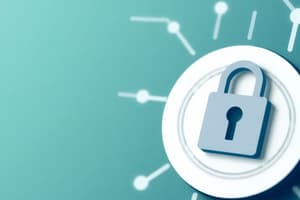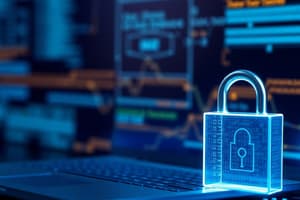Podcast
Questions and Answers
What is the primary responsibility of a LAN administrator?
What is the primary responsibility of a LAN administrator?
- Training end-users on programming languages
- Implementing security protocols for remote access
- Designing application software
- Ensuring the technical and administrative control over the LAN (correct)
What is a significant risk of not having segregation of duties (SoD) within an organization?
What is a significant risk of not having segregation of duties (SoD) within an organization?
- Inaccurate financial documentation (correct)
- Increased employee satisfaction
- Enhanced data backup procedures
- Streamlined decision-making processes
Which type of responsibilities should a LAN administrator not have?
Which type of responsibilities should a LAN administrator not have?
- Systems programming
- End-user support
- Network troubleshooting
- Application programming (correct)
What is the primary role of an auditor in the context of information security?
What is the primary role of an auditor in the context of information security?
Which of the following duties is not typically included in the segregation of duties?
Which of the following duties is not typically included in the segregation of duties?
What is the advisable reporting structure for LAN administrators in a decentralized operation?
What is the advisable reporting structure for LAN administrators in a decentralized operation?
Which role can be responsible for information security if a Chief Information Security Officer (CISO) is not present?
Which role can be responsible for information security if a Chief Information Security Officer (CISO) is not present?
What is an essential characteristic of the IT Steering Committee?
What is an essential characteristic of the IT Steering Committee?
What can occur if senior management fails to recognize their governance responsibilities?
What can occur if senior management fails to recognize their governance responsibilities?
Who typically has the ultimate legal responsibility for information security within an organization?
Who typically has the ultimate legal responsibility for information security within an organization?
Which of the following statements about the membership of the ISSC is true?
Which of the following statements about the membership of the ISSC is true?
What is one of the functions of the IT Steering Committee?
What is one of the functions of the IT Steering Committee?
Which of the following is NOT a potential consequence of failing to implement good governance in information security?
Which of the following is NOT a potential consequence of failing to implement good governance in information security?
What is a primary function of the IT steering committee?
What is a primary function of the IT steering committee?
Which task is NOT typically performed by the IT steering committee?
Which task is NOT typically performed by the IT steering committee?
How does the IT steering committee support information security?
How does the IT steering committee support information security?
What should each enterprise have for its IT steering committee?
What should each enterprise have for its IT steering committee?
Which area does the IT steering committee NOT typically oversee?
Which area does the IT steering committee NOT typically oversee?
Which statement best describes the relationship between the IT steering committee and the board of directors?
Which statement best describes the relationship between the IT steering committee and the board of directors?
What is essential for IS auditors concerning the IT steering committee?
What is essential for IS auditors concerning the IT steering committee?
Which of the following accurately reflects the responsibility of the IT steering committee?
Which of the following accurately reflects the responsibility of the IT steering committee?
Which phase is not included in the project life cycles that a system security engineer supports?
Which phase is not included in the project life cycles that a system security engineer supports?
What is a critical responsibility of the applications staff in maintaining production environments?
What is a critical responsibility of the applications staff in maintaining production environments?
Which action must IT management take to ensure proper monitoring of infrastructure staff?
Which action must IT management take to ensure proper monitoring of infrastructure staff?
Which of the following is a responsibility of network administrators?
Which of the following is a responsibility of network administrators?
What must be tightly controlled regarding infrastructure staff?
What must be tightly controlled regarding infrastructure staff?
Which type of networks are typically managed by network administrators?
Which type of networks are typically managed by network administrators?
Concurrent interactions with which disciplines are part of the system security engineer's responsibilities?
Concurrent interactions with which disciplines are part of the system security engineer's responsibilities?
What is essential for effective management of staff who develop the application?
What is essential for effective management of staff who develop the application?
What is one of the main responsibilities of a systems administrator?
What is one of the main responsibilities of a systems administrator?
In larger enterprises, how are systems administrators typically organized?
In larger enterprises, how are systems administrators typically organized?
What is required to ensure adequate security administration?
What is required to ensure adequate security administration?
What should a security administrator regularly evaluate?
What should a security administrator regularly evaluate?
What is one of the main tasks of the database administrator (DBA)?
What is one of the main tasks of the database administrator (DBA)?
Which of the following is a duty of the security administrator?
Which of the following is a duty of the security administrator?
Why might a small organization find it impractical to hire a full-time security administrator?
Why might a small organization find it impractical to hire a full-time security administrator?
What is a primary focus of the systems administrator related to security?
What is a primary focus of the systems administrator related to security?
Flashcards are hidden until you start studying
Study Notes
Information Security Steering Committee (ISSC)
- The ISSC is a crucial component of an organization's information security governance structure.
- Membership should be tailored to the organization's context and control objectives, with representatives from senior management, each line of business, corporate departments (like HR and finance), and the IT department
- The ISSC's responsibilities should be defined in a formal charter, with members having the authority to make decisions within their respective areas.
- The ISSC should not become involved in routine IT operations.
- The ISSC has a number of primary functions, which include reviewing long- and short-range IT plans, major hardware and software acquisitions, and IS projects, as well as approving sourcing strategies, resource allocation decisions, and information security management programs.
- The ISSC should ensure the alignment of IT activities with corporate objectives, and report on IS activities to the board of directors.
IT Steering Committee
- The IT steering committee provides oversight of the IT function and its activities.
- It should have members who understand the risks and issues associated with IT and who can ensure alignment with the corporate mission and objectives.
- Membership should include representatives from senior management, each line of business, corporate departments, such as HR and finance, and the IT department.
- The IT steering committee should have a formal charter defining its duties and responsibilities.
- Members should be knowledgeable about IT department policies, procedures, and practices.
- The IT steering committee typically acts as a review board for major IT projects.
Matrix of Outcomes and Responsibilities
- The matrix displays the relationships between the outcomes of effective security governance and management responsibilities.
- The matrix is intended to illustrate some primary tasks and the management level responsible for them.
- It emphasizes that the roles and responsibilities should exist, even if different labels are used for management titles in various organizations.
Security Administration
- Security administration is a critical function that begins with management commitment.
- Management must understand and evaluate security risks, and develop and enforce a written security policy that outlines standards and procedures.
- The duties of the security administrator should be defined in the policy.
- The security administrator should ideally be a full-time employee who reports directly to the infrastructure director.
- The security administrator ensures that users comply with the corporate security policy, and oversees access to company assets.
- The security administrator's responsibilities include maintaining access rules, ensuring the security of user IDs and passwords, monitoring security violations, reviewing and evaluating the security policy, preparing and monitoring security awareness programs, testing the security architecture, and collaborating with compliance, risk management, and audit functions.
Database Administration
- The database administrator (DBA) is responsible for defining and maintaining the data structures within the corporate database system.
- The DBA must understand the organization's data requirements, user data, and data relationships.
- The DBA is responsible for the security of the shared data stored on database systems.
System Security Engineer
- The system security engineer provides technical information system security engineering support to the organization.
- The system security engineer contributes to project life cycles, organizational activities, and interactions with other disciplines, and works with other organizations on activities like acquisition, system management, and certification.
Applications Development and Maintenance
- Applications staff are responsible for developing and maintaining applications, including developing new code and modifying existing application configurations.
- Management must ensure that staff cannot modify production programs or data, as development occurs in a test-only environment.
- Development work must be transferred to another group for deployment into the production environment.
Infrastructure Development and Maintenance
- Infrastructure staff are responsible for maintaining the systems software, including the operating system.
- This function requires staff to have broad access to the entire system, requiring close management monitoring through electronic logs to capture and prevent alteration of activity records.
- Infrastructure staff should have access limited to the system libraries of the specific software they maintain.
- The use of domain administration and superuser accounts should be tightly controlled and monitored.
Network Management
- Network administrators are responsible for key network infrastructure components, such as routers, switches, firewalls, network segmentation, performance management, and remote access.
- The geographic dispersion of networks often requires dedicated administrators for each local area network (LAN).
- Network administrators may report to the director of the information processing facility (IPF) or, in decentralized operations, to the end-user manager, with a dotted line reporting relationship to the IPF director recommended.
- The network administrator controls the LAN technically and administratively, ensuring transmission link functionality, system backups, authorized software and hardware purchases, and proper installation.
- In smaller settings, the network administrator may also be responsible for LAN security administration.
- The LAN administrator should typically avoid application programming responsibilities but may have some involvement in systems programming and end-user tasks.
Segregation of Duties (SoD) Within IT
- Adequate SoD is crucial for preventing errors, misappropriations, and fraudulent activities.
- SoD involves separating critical functions to prevent a single person from controlling multiple aspects of a process that could lead to undetectable errors or misappropriations.
- Duties that should be segregated include custody of assets, authorization, and recording transactions.
- The lack of SoD can lead to misappropriation of assets, misstated financial statements, and inaccurate financial documentation.
Studying That Suits You
Use AI to generate personalized quizzes and flashcards to suit your learning preferences.





